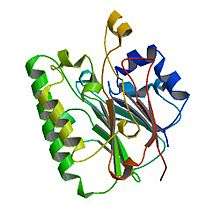Crc (protein)
| Crc | |||||||||
|---|---|---|---|---|---|---|---|---|---|
 Crystal structure of Crc in Pseudomonas aeruginosa.[1] | |||||||||
| Identifiers | |||||||||
| Symbol | Crc | ||||||||
| Pfam | PF03372 | ||||||||
| CDD | cd08372 | ||||||||
| |||||||||
The Catabolite repression control (Crc) protein participates in suppressing expression of several genes involved in utilization of carbon sources in Pseudomonas bacteria. Presence of organic acids triggers activation of Crc and in conjunction with the Hfq protein genes that metabolize a given carbon source are downregulated until another more favorable carbon source is depleted.[2] Crc-mediated regulation impact processes such as biofilm formation,[3] virulence [4] and antibiotic susceptibility.[5]
Interactions
A consensus sequence targeted by Crc mediated regulation
Hfq and Crc bind to A-rich sequences in the ribosome binding sites of genes that code for carbon utilization enzymes and consequently suppress their translation.[6]
References
- ↑ Wei, Y; Zhang, H; Gao, Z.-Q.; Xu, J.-H; Liu, Q.-S; Dong, Y.-H (2013). "Structure analysis of the global metabolic regulator Crc from Pseudomonas aeruginosa.". IUBMB Life. 65 (1): 50–57. PMID 23281037. doi:10.1002/iub.1103.
- ↑ Sonnleitner, E; Bläsi, U (2014). "Regulation of Hfq by the RNA CrcZ in Pseudomonas aeruginosa Carbon Catabolite Repression.". PLOS Genetics. 10 (6): e1004440. PMC 4063720
 . PMID 24945892. doi:10.1371/journal.pgen.1004440.
. PMID 24945892. doi:10.1371/journal.pgen.1004440. - ↑ O'Toole, GA; Gibbs, KA; Hager, PW; Phibbs, PV jr; Kolter, R (2000). "The global carbon metabolism regulator Crc is a component of a signal transduction pathway required for biofilm development by Pseudomonas aeruginosa.". J Bacteriol. 182: 425–431. doi:10.1128/jb.182.2.425-431.2000.
- ↑ Zhang, L; Chiang, WC; Gao, Q; Givskov, M; Tolker-Nielsen, T; et al. (2012). "The catabolite repression control protein Crc plays a role in the development of antimicrobial-tolerant subpopulations in Pseudomonas aeruginosa biofilms.". Microbiology. 158: 3014–3019. PMID 23023972. doi:10.1099/mic.0.061192-0.
- ↑ Yeung, AT; Bains, M; Hancock, RE (2011). "The sensor kinase CbrA is a global regulator that modulates metabolism, virulence, and antibiotic resistance in Pseudomonas aeruginosa.". J Bacteriol. 193: 918–931. PMC 3028677
 . PMID 21169488. doi:10.1128/jb.00911-10.
. PMID 21169488. doi:10.1128/jb.00911-10. - ↑ Sonnleitner, E; Bläsi, U (2014). "Regulation of Hfq by the RNA CrcZ in Pseudomonas aeruginosa Carbon Catabolite Repression.". PLOS Genetics. 10 (6): e1004440. PMC 4063720
 . PMID 24945892. doi:10.1371/journal.pgen.1004440.
. PMID 24945892. doi:10.1371/journal.pgen.1004440.
This article is issued from
Wikipedia.
The text is licensed under Creative Commons - Attribution - Sharealike.
Additional terms may apply for the media files.